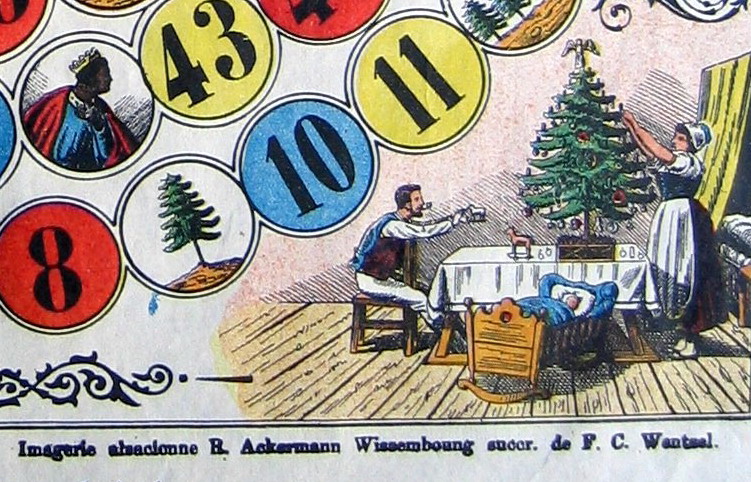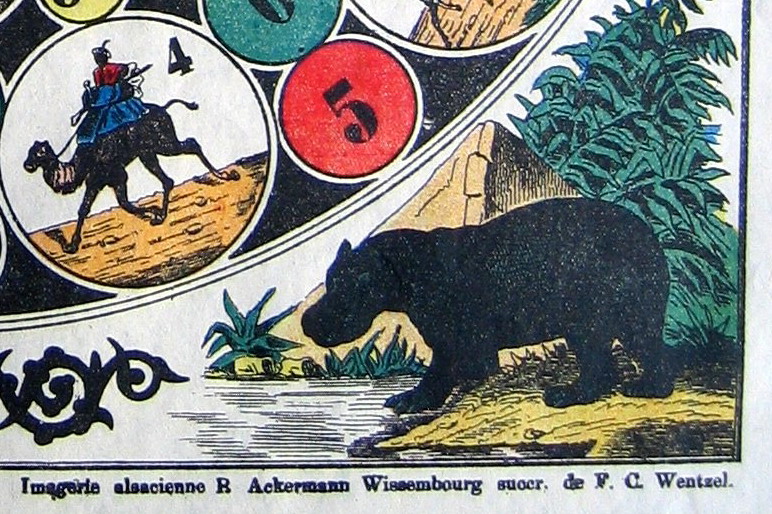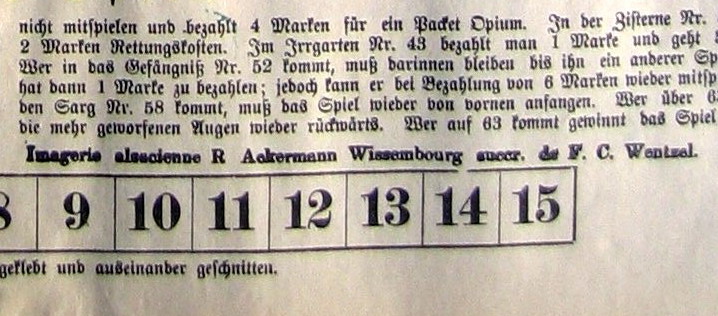Giochi dell'Oca e di percorso
(by Luigi Ciompi & Adrian Seville)
(by Luigi Ciompi & Adrian Seville)

|
Giochi dell'Oca e di percorso
(by Luigi Ciompi & Adrian Seville) |

|
| Torna alla ricerca giochi |
| Nome autore: | Ackermann Rudolph (Imagerie Alsacienne-Wissembourg) |
| Nazionalità: | Germania-Schneeberg |
| Città: | Wissembourg |
   |
Rudolph Ackermann La tradizione dell' "Imagerie" comincia a Wissembourg (Basso Reno) nel XVIII secolo con una produzione di Gottelbriefe (lettere di battesimo), poi Guillaume Brossmann vi realizza delle stampe per il divertimento dei bambini, essenzialmente delle stampe militari, utilizzando un apparecchio realizzato da lui stesso. Nel 1838 Frédéric Wentzel con una sessantina di operai e con l'aiuto di artisti che avevano esposto al Salone o studiato a Monaco, inonda l'Europa, da Dublino a Varsavia, di oltre un milione di tavole all'anno. La guerra del 1870 obbliga la famiglia Wentzel a vendere l' attività. Questa viene ripresa da C. Burckardt nel 1880, poi da E. Schenk e H. Jungk nel 1889 e infine da R. Ackermann nel 1906. Rudolph Ackermann Biography He attended the Latin school in Stollberg, but his wish to study at the university was made impossible by lack of financial means, and he therefore became a saddler like his father. He worked as a saddler and coach-builder in different German cities, moved from Dresden to Basel and Paris, and then, 23 years old, settled in London. He established himself in Long Acre, the centre of coach-making in London and close to the market at Covent Garden. His extraordinary business instinct, as well as his flair for design and talent for self-promotion, won him the £200 contract to design the ceremonial coach for the Lord Chancellor of Ireland, John FitzGibbon, 1st Earl of Clare. After this he designed The Royal Sailor, an 8-wheel omnibus that ran between Charing Cross, Greenwich and Woolwich. Ackermann then moved to Little Russell Street where he published Imitations of Drawings of Fashionable Carriages (1791) in order to promote his coach-making. Other publications followed. In 1795 he established a print-shop and drawing-school at 96 Strand.[3] Ackermann set up a lithographic press and began a trade in prints. He later began to manufacture colours and thick carton paper for landscape and miniature painters. Within three years the premises had become too small and he moved to 101 Strand, in his own words "four doors nearer to Somerset House", the seat of the Royal Academy of Arts. In 1809 he applied his press to the illustration of his Repository of Arts, Literature, Fashions, which appeared monthly until 1829, when forty volumes had appeared. Thomas Rowlandson and other distinguished artists were regular contributors. Repository documented the changing classicising fashions in dress and furniture of the Regency. He also introduced the fashion of the once popular Literary Annuals, beginning in 1823 with Forget-Me-Not; and he published many illustrated volumes of topography and travel, including The Microcosm of London (3 volumes, 1808 -1811), Westminster Ab-bey (2 volumes, 1812), The Rhine (1820) and The World in Miniature (43 volumes, 1821-6). In 1801 he patented a method for rendering paper and cloth waterproof and erected a factory in Chelsea to make it. He was one of the first to illuminate his own premises with gas. Indeed, the introduction of lighting by gas owed much to him. After the Battle of Leipzig, Ackermann collected nearly a quarter of a million pounds sterling for the German casualties. He also patented the Ackermann steering geometry. He was buried at St Clement Danes in The Strand, London. (Wikipedia, 15/10/2018) ACKERMANN, RUDOLPH (1764-1834), Anglo-German inventor and publisher, was born on the 20th of April 1764 at Schneeberg, in Saxony. He had been a saddler and coach-builder in different German cities, Paris and London for ten years before, in 1795, he established a print-shop and drawing-school in the Strand. Ackermann set up a lithographic press, and applied it in 1817 to the illustration of his Repository of Arts, Literature, Fashions, &c. (monthly until 1828 when forty volumes had appeared). Rowlandson and other distinguished artists were regular contributors. He also introduced the fashion of the once popular English Annuals, beginning in 1825 with Forget-me-not; and he published many illustrated volumes of topography and travel, The Microcosm of London (3 vols., 1808-1811), Westminster Abbey (2 vols., 1812), The Rhine (1820), The World in Miniature (43 vols., 1821-1826), &c. Ackermann was an enterprising man; he patented (1801) a method for rendering paper and cloth waterproof, erected a factory at Chelsea for the purpose and was one of the first to illuminate his own premises with gas. Indeed the introduction of lighting by gas owed much to him. After the battle of Leipzig Ackermann collected nearly a quarter of a million sterling for the German sufferers. He died at Finchley, near London, on the 30th of March 1834. (Encyclopædia Britannica, 15/10/2018) Rudolph Ackermann Ackermann (publisher/printer; printmaker; German; British; Male; 1764; 1792 - 1834; 1992; Rudolph Ackermann; the Ackermann business under various names) Also known as: Ackermann, Rudolph; Ackermann & Co; R Ackermann & Co; R. Ackermann's Lithographic Office; Ackermann's Lithographic Press; Repository of Arts; Ackermann, Arthur; Arthur Ackermann & Son; R Ackermann Junr. Address: Wissembourg, as Imagerie alsacienne (successor of the business of F. C. Wentzel; Ackermann also succeeded C. Burckardt in Wissembourg) 96 Strand, London (1795-1806; 1827-56, as The Repository of Arts, in 1832 and in 1834 as Messrs Ackermann & Co, in 1836 as Ackermann & Co.) on the corner of Beaufort Buildings 101 Strand, London (1797-1825; called from 1798 The Repository of Arts) (nb this operated simultaneously with 96 Strand, as did some of the later addresses); also under this address Ackermann's Lithographic Press (in 1817) 220 Strand, London (1803) 191 Regent Street, London (from 1825, in 1835; R. Ackermann Junior's Eclipse Sporting Gallery in 1831) 106 Strand, London (1855-61) 157a New Bond Street (20th century) 3 Old Bond Street (20th century) 33 Old Bond Street (1991) Biography Lithographer, publisher. Rudolph Ackermann, born in Saxony; to London 1787; 1792, set up in business as a coachmaker at 7 Little Russell Street, Covent Garden, having already published the first of many books of carriage designs; 1796, moved to 96 Strand where he ran a drawing school for ten years, publishing drawing books; 1797, to 101 Strand (known, from 1798, as "The Repository of Arts") where he sold old master paintings and artists' supplies as well as prints (see 1871,1209.5668 for an advertisement). 220 Strand given as his address in a print published 1803. "The Microcosm of London" (1808-10) and the monthly "Repository of Arts" (1809-29) established his reputation for fine colour plate books. 1809 naturalised. 1816, began to publish lithographs. Always maintained links with Germany, and in the 1820s also opened outlets in Mexico, Guatemala, Colombia, Argentina, and Peru. 1832, handed over to his second son George (q.v.) and his younger brothers who traded as Ackermann & Co.at 106 The Strand until 1861 (although the brothers' partnership dissolved in 1855); the print business which Ackermann had established for his eldest son Rudolph at 191 Regent Street (later in Bond Street) survived as Arthur Ackermann & Son. In the 1930s it opened branches in America, eg at 408 South Michigan Avenue Chicago. In 1991 the firm closed, and re-opened again in 1992 as Arthur Ackermann and Peter Johnson Ltd. (British Museum, 15/10/2018) Rudolph Ackermann (dal 1906). Rudolph Ackermann (Schneeberg, 20 aprile 1764 – Finchley, 30 marzo 1834) è stato un inventore, editore e industriale tedesco. Pioniere della litografia, produsse alcune delle migliori stampe a colori della Gran Bretagna, pubblicando numerosi volumi illustrati e riviste. Biografia Nacque il 20 aprile 1764 a Schneeberg, in Sassonia. Il padre era un esperto sellaio mentre per quanto riguarda la madre non è stato ritrovato alcun documento che ne testimoni la mansione. Da ragazzo Ackermann studia e viene formato in una scuola di latino. Finiti gli studi la sua intenzione era quella di intraprendere il cammino universitario, idea però resa impossibile dalla precaria situazione economica della famiglia quindi fu costretto a lavorare come apprendista sellaio con il padre. In seguito lavorò come carrozziere occupandosi della manutenzione e della progettazione di carrozze, questo mestiere lo portava spesso a spostarsi per tutta la Germania. In contemporanea alle sue prime esperienze lavorative Ackermann si distinse anche come uno specialista e divulgatore del culturismo. Tra le sue varie destinazioni ricordiamo il breve soggiorno a Parigi dove viene in contatto con Antoine Carassi, famoso imprenditore francese. L'arrivo in Inghilterra Nel 1787 Ackermann decise di approdare in Inghilterra, destinazione Londra. Durante il soggiorno nella capitale fece conoscenza con la donna che nel 1792 sposerà; il matrimonio consentì a Ackermann di essere riconosciuto come cittadino inglese. Nell'isola Britannica Ackerman, continuò a lavorare nel settore del trasporto, arrivando a lavorare per clienti di notevole importanza, tra i più famosi ed influenti ricordiamo il primo presidente degli Stati Uniti d'America George Washington. In Inghilterra approfondì le sue conoscenze nell'arte della Litografia arrivando nel 1795 a progettare e costruire una pressa litografica in via 96 strand, questa intuizione farà di lui un pioniere delle stampe a colori, nello stesso periodo esercita il ruolo di "insegnante" nella scuola-disegno da lui stesso fondata. Fu il primo ad installare a Londra una biblioteca artistica pubblica. In seguito si buttò nell'editoria diventando famoso per la pubblicazione di bellissime incisioni all'acquatinta, di opere artistiche, stampe decorative, periodici di moda e caricature politiche. Cominciò a frequentare personalità di notevole importanza, tra le quali ricordiamo l'artista Thomas Rowlandson. (Wikipedia, 15/10/2018) Bibliography 1) J. Ford: "Ackermann, 1783-1983: The Business of Art, Ackermann & Son", 1983. 2) J. Ford: "Rudolph Ackermann", Oxford Dictionary of National Biography, 2004-8. 3) C. Nieder: "Rudolph Ackermann und die englischen Hilfsaktionen 1807 und 1813", Neues Archiv für sächsische Geschichte und Altertumskunde, 1921, pp. 242-255. |
Vai alla ricerca giochi Vai all'elenco autori